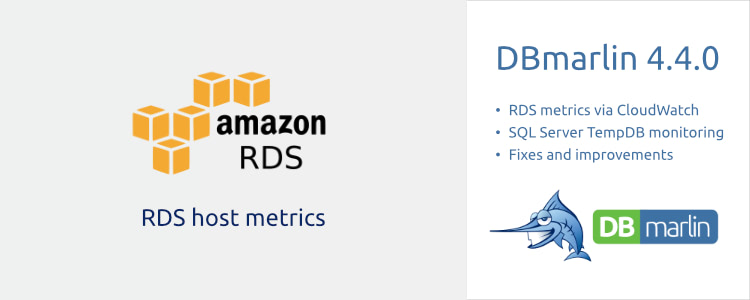DBmarlin 4.4.0 adds SQL TempDB and AWS CloudWatch monitoring

We are pleased to announce the release of DBmarlin 4.4, a significant step forward. This version introduces AWS CloudWatch monitoring for Amazon RDS host metrics as well as TempDB monitoring for Microsoft SQL Server.
AWS CloudWatch monitoring for Amazon RDS
Monitoring all the database engines provided by Amazon RDS has been possible for a long time with DBmarlin, but one thing we lacked until now was the ability to get host metrics. With DBaaS (Database-as-a-service) platforms such as Amazon RDS (Relational Database Service), the host layer is managed by the cloud vendor, which means that the DBmarlin Windows and Linux host sensors aren’t applicable. In DBmarlin 4.4, we have added the ability to get host metrics such as CPU, Memory, and Disk metrics via the AWS CloudWatch API. This can be set up under host settings just like adding Linux or Windows host sensors and provides a similar set of metrics to these.
Microsoft SQL Server TempDB monitoring
Monitoring Microsoft SQL Server TempDB usage is crucial for maintaining database performance and ensuring the smooth operation of SQL Server environments. TempDB is a system database used for temporary storage needs such as temporary tables, worktables, and intermediate result sets. High TempDB usage can lead to contention and bottlenecks, negatively impacting overall server performance. In DBmarlin 4.4, we have added a new screen to visualize TempDB use over time. For any time period, you can see a list of sessions using TempDB and drill down into the session to see more details.
Better tooltips
DBmarlin now has tooltips for event markers such as changes, custom events, and alerts, so you no longer need to visit the Events screen to see the details. Regular tooltips have also improved, with number formatting now easier to read, and metrics like ‘Time spent’ shown in hours, minutes, and seconds rather than milliseconds.
Video Walkthrough of new features
Ready to try DBmarlin?
If you would like to find out more about DBmarlin and why we think it is special, try one of the links below.
- Get hands-on without an installation at play.dbmarlin.com
- Download DBmarlin from www.dbmarlin.com, with one FREE standard edition license, which is free forever for 1 target database.
- Join our new community at https://community.dbmarlin.com/invitation?code=74020A

